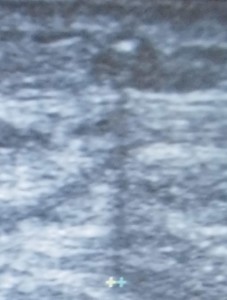Crossectomy is a procedure which ligates the great saphenous vein (GSV) at its termination into the femoral vein. Usually, all the draining tributaries are ligated similarly as they join the GSV termination. The procedure can be performed under local or general anaesthetic. It can be combined with stripping of the GSV or performed alone if saphenous sparing surgery is used. The aim is to remove all possible groin sources of reflux into the GSV. An important step is to interrupt the anterior accessory saphenous vein (AASV) at its termination as this is a common source of recurrence. An incompetent AASV may exhibit antegrade flow in the presence of GSV reflux due to a siphon effect. This AASV may be revealed only when the GSV reflux has been removed. The main side-effect of a crossectomy is neovascularisation which is very rare with endovenous ablation techniques. Crossectomy can be used in combination with UGFS into the GSV.
DIMITRI BOUNTOUROGLOU Crossectomy with concurrent UGFS under local anaesthetic is a contemporary technique for the treatment of primary varicose veins. We have shown that it has good short, medium and long term results, comparable or even superior to traditional crossectomy and stripping. It was conceived originally to change the traditional operation of a crossectomy and saphenous strip from a general anaesthetic operation into a local anaesthetic procedure. The painful stripping part is replaced by a foam injection and the crossectomy was designed to discourage foam migration into the deep veins. Another advantage is that, in contrast to all other endothermal ablation (ETA) procedures, tumescence is not required.
With crossectomy and concurrent UGFS, operative treatment time is significantly shorter with a reduced cost compared to the traditional “tie and strip” technique. Furthermore, there is an earlier return to work. Quality of life analysis showed that the early advantages of the crossectomy and foam technique are statistically significant with regard to amount of discomfort and the cosmetic aspects related to the procedure. At a follow-up of 5 years, both treatments were equally effective as shown by the venous clinical severity score and the SF-36 quality of life score.
